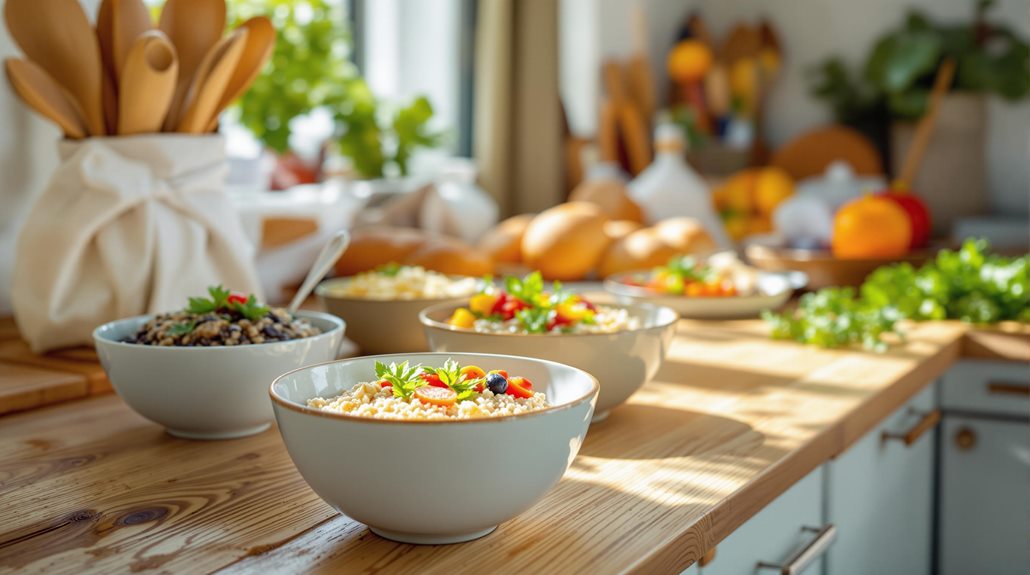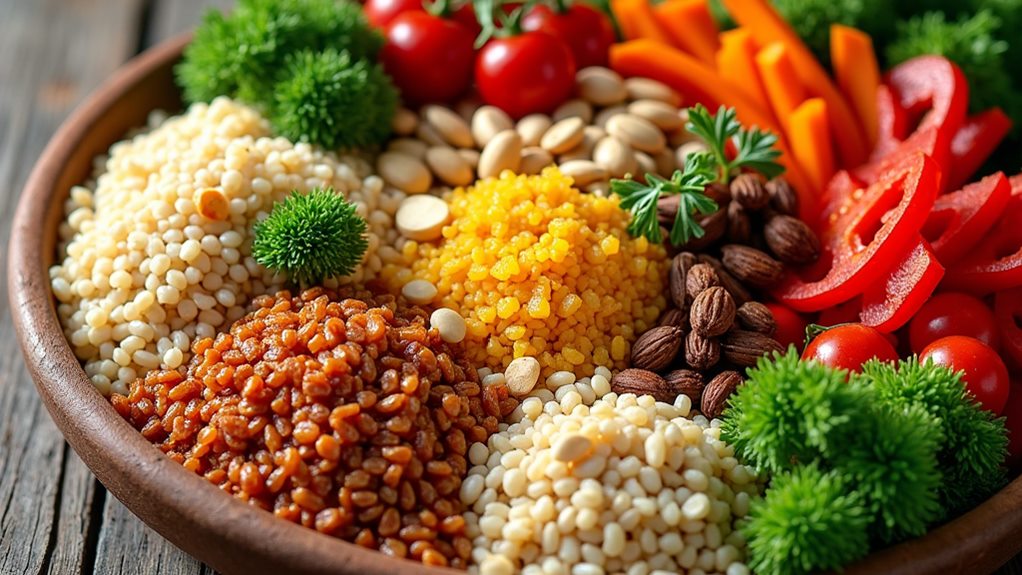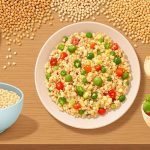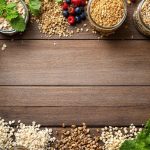
You won’t believe how easy it is to boost your diet with whole grains! Start by swapping white bread and pasta for their whole grain counterparts for an instant fiber and nutrient upgrade. Enhance your meals by adding quinoa or brown rice to salads and soups for an extra health punch. Shopping smart is crucial—look for the Whole Grains Council’s stamp and prioritize products with whole grains listed first. Don’t fear experimenting; try bulgur or farro for a delightful twist. Lastly, make oatmeal your breakfast go-to. Want to truly revolutionize your meals? There’s more to explore.
Simplify With Whole Grain Swaps
Transforming your diet doesn’t have to be complicated—just simplify with these whole grain swaps. Want to slash your risk of heart disease? Trade that white bread for whole grain varieties. Whole grain foods retain the bran and germ, giving you fiber and nutrients that refined grains simply can’t match. Ditching white bread is an easy first step toward better heart health and ensures adequacy in your nutrient intake.
Next, banish white rice from your pantry. Instead, opt for brown rice or quinoa. These whole grains are packed with more fiber and essential nutrients, making them superior choices. Why settle for less when you can choose better for your body’s health?
Tired of spiking blood sugar from breakfast cereals? Whole oats are your new best friend, loaded with fiber to fuel your morning and promote digestive health. Your metabolism will thank you for the steady energy.
Craving carbs? Whole grain pasta and whole grain crackers are your go-to alternatives. Unlike refined options, they add more whole grains to your diet, enhancing satiety and weight management. It’s time to say goodbye to processed junk and fully embrace the health benefits of whole grains. You’re just a swap away from feeling fantastic!
Enhance Meals With Grains
Swapping refined grains for whole grains is just the beginning of revitalizing your diet. Are you ready to level up your meals with these nutrient powerhouses? Dive into the health benefits of whole grains and enjoy a diet high in fiber, promoting not only a sense of fullness but also potentially lowering cholesterol levels. Adding whole grains can be particularly beneficial for those mindful of ingredient transparency, as outlined by the FDA priorities in labeling regulations. Add cooked brown rice or quinoa to soups and salads; these ingredients are winners in transforming bland dishes into fiber-rich masterpieces.
Think about ditching those white flour tortillas. Whole grain wraps aren’t just trendy—they’re nutritious, satisfying, and the perfect lunchtime upgrade. Hungry for more variety? Whole grain pasta offers a delightful texture and a hefty dose of vitamins and minerals absent in its refined cousins, making dinner sensationally nutritious and satisfying.
How about giving your proteins a crunchy edge? Whole grain breadcrumbs do just that, enriching your meals with fiber and a nutty flavor that’s utterly irresistible. Trying these whole grain products isn’t just about swapping; it’s about putting your health first and adding whole grains into every meal. So, don’t wait, enhance your meals, and let whole grains lead the way.
- Oatmeal instead of refined cereals for breakfast
- Whole grain pasta in your favorite pasta dishes
- Nutty flavor boost with whole grain breadcrumbs
Master Whole Grain Shopping

Navigating the world of whole grains doesn’t have to be a mystery. You’re about to become a master of whole grain shopping! First, trust the Whole Grains Council’s 100% stamp—it guarantees that the product contains only whole grains. When you’re scanning those food labels, always check the ingredient list. Prioritize whole grains like whole wheat, oats, or bran listed first. Unlike those processed foods high in sodium and sugar, these whole grains provide essential nutrients that promote overall health. Those “multigrain” or “natural” labels? Don’t be fooled. They often lack real health benefits unless they’re true whole grain foods.
Next, pay close attention to the fiber per serving. Aim for at least 3 grams. This indicates the product has a higher content of those coveted whole grains. Don’t forget the powerful health benefits these grains bring, from supplying healthy fats to supporting heart health.
Want to diversify your intake? Explore your local grocery store or farmers’ market. You’ll discover an array of wholesome options like farro or bulgur that fit seamlessly into your diet. By mastering whole grain shopping, you’re not just adding variety to your meals; you’re investing in your health subtly and deliciously. So, next time you shop, be bold and make those grains work for you!
Experiment With New Grains
With your whole grain shopping skills sharp, it’s time to explore and redefine your culinary boundaries. It’s an opportunity to break free from the mundane and inject life into your meals using whole grains like quinoa, barley, bulgur, and farro. Quinoa isn’t just a trendy grain—it’s a nutrient powerhouse packed with protein that fulfills your gluten-free desires. Imagine enhancing your dishes with this healthy staple, seducing your taste buds and nourishing your body simultaneously.
- Quinoa: A complete protein and gluten-free, perfect for salads and grain bowls that don’t sacrifice flavor for health.
- Barley: Its chewy texture adds soul to soups and salads while boosting your fiber intake for better digestion and those stable blood sugar levels you crave.
- Farro: Dive into ancient nutrition and indulge in farro’s nutty flavor, rich in vitamins and nutrients, perfect for hearty grain bowls.
Bulgur, a quick-cooking marvel, transforms tabbouleh into a fiber-rich, low-glycemic delight, keeping your blood sugar steady. Experiment with mixing and matching—try the boldness of combining brown rice with black rice, letting your creativity redefine “healthy eating”. Don’t hold back; let your culinary adventures begin!
Prioritize Nutrient-Rich Options

Often, elevating your meals starts with a simple yet powerful shift—prioritizing nutrient-rich options that pack a punch. It’s time to ditch those nutrient-poor refined grains and embrace whole grains that deliver impressive health benefits. Start scrutinizing that ingredients list to spot whole grain ingredients. Make sure whole grains aren’t just present but lead the lineup as the first listed ingredient—consider that essential for whole grain breads and products.
Why settle for less when whole grains offer maximum dietary fiber, vital for digestion and feeling fuller longer? Get a variety on your plate: brown rice, quinoa, and whole-wheat flour are all excellent choices. This variety of whole grains isn’t merely about taste; it’s about ensuring a balanced diet packed with nutrients.
Don’t let sneaky labels fool you—terms like “multigrain” often disguise a lack of true whole grain content. Instead, look for certifications or the Whole Grain Council’s 100% stamp to ensure what you’re buying is legit. Aim for at least half of your grain intake to be whole grains and watch as you reduce risks of chronic diseases with this strategic, delicious shift.
Embrace Oatmeal Every Morning
Including whole grains in your daily diet is a transformative step toward a healthier lifestyle, and oatmeal serves as an exemplary addition. Its health benefits are substantial, from lowering cholesterol levels to enhancing feelings of satiety and managing weight. With its high fiber content, oatmeal not only supports heart health but also provides a nourishing breakfast that can be tailored with a variety of toppings for added nutritional value. By making oatmeal a staple of your morning routine, you can enjoy its versatility while taking proactive steps toward reducing the risks of chronic diseases, including heart disease and type 2 diabetes.
Oatmeal stands out as a versatile and nutrient-dense option that aligns with the goals of a heart-healthy diet. As you consider incorporating more whole grains into your meals, starting the day with oatmeal establishes a solid foundation for meeting the daily recommended fiber intake. This small dietary change can make a significant impact on your overall health. By experimenting with different toppings like fruits, nuts, and seeds, you introduce not only variety but also a spectrum of additional nutrients that complement oatmeal’s whole grain benefits. Regular oatmeal consumption is a practical and enjoyable way to invest in long-term well-being, underscoring the idea that small, consistent choices in your diet can lead to substantial health improvements. Prioritizing oatmeal as part of your breakfast routine can set the tone for healthier meal patterns throughout the day, promoting sustained energy levels and helping you maintain focus and productivity. Embrace the simplicity and benefits of oatmeal, and witness the positive changes it can bring to your life.














